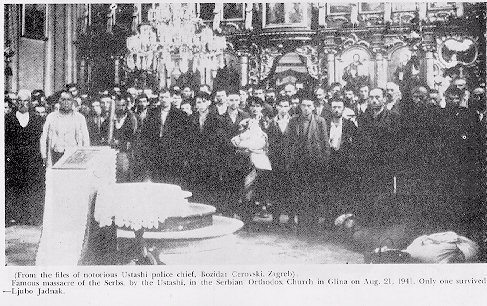|

1. Walter Gorlitz, a military official, in his book "Der Zweite Weltkrieg 1939-1945", Stuttgart, 1952. Band 11. on page 125 writes the following: "Unfortunately, one of the first measures undertaken by the Catholic Ustashi regime was a terrible military venture of extermination of the Serbian Greek-Orthodox parts of population which has come under the Croatian rule. The horrors that had taken place at that time had thrown the young country into a predestined civil war..." 2. Karlheinz Deschner, a writer, Catholic and a doctor of philosophy, in his book "Mit Gott und den Faschisten", Stuttgart, October 1965 and "Abermalsrahen der Hahn", Stuttgart, December 1962, writes the following: "The Serbs have become slaughterhouse material. In accordance with this doctrine the Ustashi started actions against Serbs, the people of the highest cultural level in the Balkans but not of the Catholic faith..." "Catholics were urged from the church pulpits to persecute Orthodox Serbs and especially arduous in this were the Franciscans whose monasteries have for a long time served as meeting grounds for the Ustashi." "Furthermore it is understood that from the total of two million Orthodox population, almost 600,000 was killed."

3. In 1953 Italian military authorities have made available to the press several documents from their archives, pertaining to the Ustashi crimes perpetrated over the Serbian people. Thus the daily "Il Tempo" of September 10, 1953, published the following excerpts from the report of the Commander of the Italian "Sasari" division: "Population in some places was completely exterminated, after having been tortured and tormented. The horrors that the Ustashi have committed over the Serbian small girls is beyond all words. There are hundreds of photographs confirming these deeds because those of them who have survived the torture: bayonetted hits, pulling of tongues and teeth, nails and breast tips (all this having been done after they were raped), were taken in by our officers and transported to Italian hospitals where these documents and facts were gathered." 4. Curzio Malaparte, one of the most famous Italian writers who attained world fame, wrote the book "Kaputt", Roma-Milano 1948 (Decima edizione). The book was published in New York, London, Barcelona, Rio de Janeiro, Brussels, Belgrade... In his book Malaparte describes his visit to Ante Pavelic, the leader of Ustashi: "While they were talking I noticed a cane basket on the left hand side of the Pavelic's desk. The cover was slightly raised: I could see that the basket was full of sea fruit. At least, that is what I thought it was. It looked like oysters but extracted from the shells, like the ones that you sometimes can see served on large plates at Fortnumm and Mason, in Piccadilly in London. Casertano looked at me and gave me a sign with his eyes:
'Are they Dalmatian oysters?' I asked Pavelic. Ante Pavelic took the lid off the basket and showed me the sea fruit, that sticky and jelly-like mass, and then said, laughing with his frank and tired laughter:

|